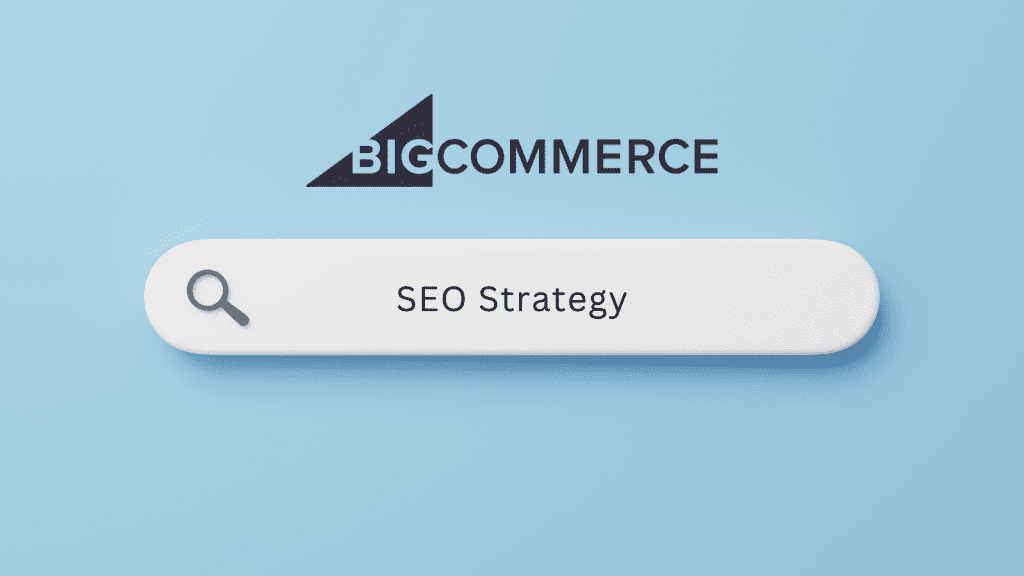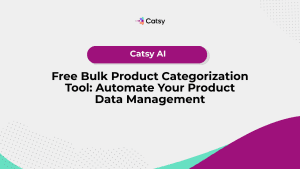BigCommerce SEO (Search Engine Optimization) Strategy: Product Info & Digital Assets

- BigCommerce offers robust SEO tools and customization options.
- PIM and DAM solutions streamline product data management, ensuring accuracy, consistency, and SEO optimization.
- A unified PIM and DAM solution seamlessly integrating with BigCommerce is the perfect ally for a successful SEO strategy.
In this Article
The latest data shows that e-commerce sales will grow by around 9% in 2024. In particular, the business-to-business (B2B) sector is projected to expand at an average CAGR of 12.9% from 2023 to 2028. These trends suggest a robust growth trajectory for the market, but is your store ready to exploit this revenue potential?
E-commerce stores provide an additional revenue stream for businesses, although some rely on this avenue as the core business environment. However, figures like those shared previously attract more players. With platforms like BigCommerce making it easy to launch an online store, overcrowding is a real risk.
Succeeding in an overcrowded market is an uphill task. For instance, just getting your store noticed requires much effort. However, many circumvented the challenges of visibility using SEO strategies. These strategies are often built around optimized product information and digital assets. You are in the right place if you are in the market for tactics to future-proof your online store because this post shares insights on building a robust SEO strategy.
Understanding BigCommerce and Its Stores
What is BigCommerce?
BigCommerce is a software application that allows merchants to build online stores to sell products and services. The platform hosts the stores, ensuring that shoppers (and even the merchants) can access them anytime, anywhere.
Founded in 2009, BigCommerce and other platforms like Magento and Shopify have played a massive role in the e-commerce boom. Each platform contributes unique features and serves that shape the way businesses operate online.
Read Also: Shopify PIM
So, what makes BigCommerce stand out?
1. Built-in features
BigCommerce’s B2B Edition is a popular choice for businesses targeting B2B buyers. This platform has a robust suite of built-in features – you can create a highly functional and successful online store without needing to purchase and manage numerous third-party apps constantly.
One example of the features is robust product management. You can easily manage your product catalog, no matter how extensive, without looking for solutions in the app store. The feature includes functionalities like:
- Support for numerous product variants and options
- Customizable product details, including rating, pricing, descriptions, and images
- Inventory tracking and management
BigCommerce also allows merchants to implement a checkout process tailored for the B2B space. For instance, your customers can create and manage user accounts, complete checkout with pre-approved payment methods, and pay their invoices in one place. This buyer portal replaces the default BigCommerce storefront account area for your direct-to-consumer (DTC) business activities.
Other features that attract merchants to BigCommerce include quick order tools, shopping lists, invoice management, and branded checkout pages. This last feature is fascinating for merchants who want to design a cohesive brand experience throughout the customer journey.
2. Flexibility
BigCommerce offers several customization options, enough to align with most of your needs. Some examples include:
- Custom product fields to capture additional product information.
- Support for several product variants, enabling businesses to offer the same item in different sizes, colors, or other variations.
- Custom pricing options include volume discounts, customer group pricing, and price lists.
- Custom workflows include approval processes, quote requests, and purchase orders.
These customization options allow businesses to tailor e-commerce experiences to specific needs and make changes to enhance your search result listings with information like ratings, pricings, and stock levels of every unique page. For example, a company selling industrial products may require custom product fields to capture technical specifications. In contrast, a wholesale product business may require custom pricing options to offer volume discounts.
3. Scalability for growth
Suppose large enterprises like power tools manufacturers are going to use an e-commerce platform to create online shops. In that case, the software must handle evolving catalog sizes and increased traffic without throttling performance. This is particularly critical for industrial brands as they move sales operations online.
BigCommerce ticks this box. It allows businesses to add unlimited products to their store, making it easy to expand their product catalog with time. Also, the platform is designed to deliver fast page load times and reliable performance, even during periods of high traffic. This ensures that businesses have sufficient capacity to handle spikes as they happen.
4. Marketing & SEO tools
Marketing is essential to business, regardless of the environment or sector. According to a recent survey, B2B companies allocate at least 10.78% of their budget to marketing. The objective is to increase their stores’ visibility, warm up, and follow up on leads.
BigCommerce has features that facilitate visibility strategies. It provides merchants with several SEO features, such as customizable URL structures, meta tags, and header tags, to help them optimize their stores for search engines. Businesses can also leverage the blog feature to create and publish articles directly from the store, helping to drive traffic and improve search engine rankings.
Other marketing tools include social media integration, integrating with several email marketing platforms, such as Mailchimp and Klaviyo, and promotional tools (create and offer discounts, loyalty programs, and coupons).
SEO is a critical element of an online business’s longevity strategy. No wonder SEO is one of the main areas marketers invest in. In fact, HubSpot data finds that 32% of marketers plan to leverage websites, blogs, and SEO as part of their overall marketing strategy in 2024.
You will likely be shopping for ideas on leveraging SEO to ensure your store that you built on BigCommerce weather competition in the future. The following section delves into the mechanics of SEO strategies in BigCommerce. The objective is to share foundational concepts to help you understand how to leverage BigCommerce’s built-in SEO capabilities.

Key Pillars of a BigCommerce SEO Strategy to Improve Rankings
Optimizing product descriptions and digital assets is vital for SEO. However, this effort may amount to naught if the foundation is shaky. Building a robust foundation for an SEO strategy begins with minding the technicals. Here’s what this means.
Technical SEO foundations
Technical search engine optimization (SEO) is making your site easier for search engines to find and index the information on the pages. It involves tuning the website to meet the technical requirements of search engines.
BigCommerce, like all other e-commerce platforms, allows users to optimize stores for search engines. Some of the things you can do to meet search engines’ technical requirements include:
- Clean site architecture and navigation: Structure your website for humans and search engine indexing algorithms. You can use a logical hierarchy of categories and subcategories to organize your products. Also, you can implement clear breadcrumbs for easy navigation.
- Mobile optimization: Any site that doesn’t work well on mobile devices will only attract 35% of all e-commerce traffic. This dismal performance may pose an existential threat to your business. So, ensure your site leverages BigCommerce’s responsive design capabilities; the feature allows sites to adapt perfectly to various screen sizes.
- Fast page load speeds: Slow websites are a common frustration for both shoppers and search engines. This tells you that potential customers will abandon your store for better alternatives. Fast load times using a content delivery network (CDN) improve user experience and positively affect your search engine rankings. Some tactics to increase page load speed include optimizing images, leveraging browser caching, and minimizing code.
- Address crawl errors and broken links: Each search engine has specialized algorithms that visit websites and index the available information. These algorithms are called crawlers. A search engine will index a website quickly and fast if it doesn’t encounter issues; the most common problems they experience are broken links that result in crawl errors. So, use tools like Google Search Console or Screaming Frog to regularly audit your store. These will point out and help you fix any technical issues, such as 404 errors, incorrect 301 redirects and URL rewrites, and broken links that undermine search engine crawlers.
Note: Neglecting technical SEO is like building a beautiful house on a weak foundation. Taking care of these foundational elements ensures your store is accessible and understood by search engines and provides the best possible overall user experience.

Keyword research that evolves
BigCommerce provides many resources to help users create a robust keyword strategy. It also provides a guide on how to design and conduct keyword research. Some highlights of BigCommerce’s guide include:
- Target diverse keywords: Don’t limit yourself to just high-volume keywords. Instead, focus on mixing transactional keywords that indicate purchase intent (e.g., “buy industrial drill press”), informational keywords that address research needs (e.g., “best industrial drill press for metal”), and long-tail keywords that are particular phrases (e.g., “heavy-duty industrial drill press for steel fabrication”). This multifaceted approach casts a wider net to attract potential customers at different stages of their buying journey.
- Understand buyer intent: Beyond just keywords, consider what your potential customers are searching for. For instance, what problems are they trying to solve, or what information are they seeking? Focusing on the intent increases the likelihood of meeting shoppers’ needs and appearing in relevant search results.
- Utilize SEO tools: Keyword research tools provide valuable data like search volume, competition level, and related keywords. They also offer competitor analysis, revealing what keywords other successful stores in your niche are targeting.
- Continuous adaptation: Keyword research that evolves requires nonstop work. You must continuously monitor your search ranking on search engine results pages (SERPs) and analyze website traffic. The resulting insights should help you adjust your strategy to stay ahead of evolving trends.
The bottom line is that your keyword research strategy must be smart. Smart keyword research is like having a compass to guide optimization efforts. It helps you tap into the language your ideal customers use and create content that addresses their needs.
On-page optimization
This approach involves adjusting your site’s design and content to increase the odds of search engine crawlers indexing it and serving it as a top result on SERPs. On-page optimization is a crucial aspect of any BigCommerce SEO strategy because it makes your store more accessible to users and understandable for search engines.
Several actions undertaken within your website add up to on-page optimization. Product page optimization is a great example; this is one of the most critical aspects of on-page optimization because it affects the most essential part of your store. Product pages are where potential customers make purchasing decisions.
How can you adjust the product page to benefit SEO?
You can include compelling titles, leverage keywords strategically, and use meta descriptions. Utilizing product keywords in the page copy, SEO-friendly URLs, and image alt tags can also help improve the page’s relevance for those keywords.
Category pages are another vital aspect of BigCommerce on-page optimization. Well-written category descriptions can help businesses establish their expertise and authority in their niche.
Blog content rounds off the actions you can take within the website for excellent SEO. A well-maintained blog is a potent SEO tool. This means writing high-quality articles that address relevant topics– the posts should incorporate keywords without tampering with the content’s natural flow. These blog posts can provide valuable BigCommerce SEO tips or answer common questions. The objective is to establish yourself as an authority in your niche.
We noted earlier that BigCommerce has numerous resources to guide users throughout the SEO strategy development and implementation process. The platform even provides a checklist to ensure businesses create a compelling strategy. Here is an overview:
BigCommerce SEO Checklist
Setup:
- Apply a domain
- Enable Sitewide HTTPS with SSL
- Verify domain and submit sitemap to Google and Bing
- Set up Google Search Console and Google Analytics
Research:
- Conduct market research to understand the target audience
- Create a spreadsheet to track findings
- Use built-in SEO tools like Google Ads Keyword Planner, Ahrefs, or SEMRush for keyword research
- Focus on short-tail and long-tail keywords
- Develop keyword themes for content creation
Write:
- Incorporate primary and secondary keywords into important pages
- Write content for users, not just search engines
- Avoid keyword stuffing and duplicate content
- Create unique content for each page
- Structured data for rich snippets
- Optimize homepage, web pages, and product pages with relevant keywords and image descriptions
Products:
- Enhance product descriptions with images, testimonials, and videos
- Include high-quality imagery on category pages
- Add image descriptions (alt tags) for all product images
- Fill out page titles and meta descriptions for products and categories
Build Links:
- Conduct competitor backlink analysis
- Identify backlink opportunities
- Utilize tools to find influencers for brand promotion
- Partner with influencers to create valuable content
Track & Measure:
- Monitor SEO performance with key performance indicators (KPIs)
- Use analytics software like Google Analytics to gather data
- Regularly check and record progress
- Utilize Google Analytics for real-time audience, acquisition, behavior, and conversion reports
- Implement e-commerce analytics to measure SEO impact on revenue
Search Engine Optimization for Your BigCommerce Product Information and Digital Assets
We’ve laid out the essential pillars of a robust BigCommerce SEO strategy. However, the reality is that technical SEO, keyword research, and on-page optimization can only take you so far. This strategy fails if your product information and digital assets are inaccurate, inconsistent, or outdated.
Recall that all the optimization actions taken are applied to the content on your website. Therefore, product content must be reliable first if the SEO strategy is to deliver the desired results.
Prioritize product data accuracy and completeness.
Shoppers want all the details they need in one location when they visit product pages. They also want this information to be accurate and consistent across all platforms they encounter with your products. Many issues can arise if there is conflict in this regard.
Search engines also prioritize accuracy and completeness. Detailed product descriptions, correct technical specifications, and optimized images contribute to relevant search results. Search engines may not understand your products fully in case of inaccurate or missing information. This undermines your odds of ranking well on SERPs.
This may be easy to say, but anyone with experience in product data management can attest that the task can easily overwhelm teams. The issue compounds if you rely on inventory management systems (spreadsheets, ERPs) to store, organize, and manage the data.
Besides too much human involvement (which leads to many errors), these systems create room for inconsistencies. For example, there is no way to manage spreadsheets centrally. Again, the product details in ERPs are only suitable for logistics and other internal operations. For instance, customers cannot understand the raw data in an ERP system.
So, the first step toward prioritizing product data accuracy, completeness, and consistency is adopting product information management software.
PIM software does three things that build a robust foundation for a successful BigCommerce SEO strategy.
1. PIM consolidates product data
The tool aggregates product information from various sources (ERP, CRM, etc.) into a single platform. This eliminates inconsistencies and streamlines data management.
2. PIM enriches product details
No matter how much you try to optimize the “skeletal” product information in inventory management systems for search engines, the effort may not bear any fruit. The strategy may entice search engines, ranking your product pages favorably, but that is where the road ends. No shopper will find it helpful because of the thin and illegible nature of the details.
Product content management software takes these ostensibly meaningless details and adds meaning. The tool allows users to create customer-readable and understandable product descriptions and technical specifications, as well as add metatags. They may also transform features into benefits to help accelerate purchasing decisions.
3. PIM optimizes content for SEO
During the enrichment process, you can integrate relevant keywords. This increases your product pages’ organic visibility to search engines and potential customers.
Also, PIM software adds depth to product details, and search engines love in-depth content! PIM SaaS solutions allow you to create detailed descriptions. This enriched data improves your chances of ranking higher in relevant search results.
Don't forget to optimize product images.
Product images are a crucial aspect of e-commerce; they help entice potential customers to purchase. However, this content significantly impacts page speeds; if unoptimized, product images can slow your site’s loading to a crawl.
Just like PIM software smoothens the issues around product information, digital asset management software helps to optimize product images.
DAM solutions centralize all your product images in a single, accessible location. This eliminates the time-consuming task of searching through scattered folders or relying on external storage services.
Most DAM software provides essential image editing tools to make necessary adjustments like cropping and resizing; this is essential to conform to BigCommerce’s recommended dimensions, ensuring a visually consistent presentation across your store.
The platform also contributes to the SEO efforts. DAM allows you to rename a product image with descriptive keywords that accurately reflect your product. This best practice improves search engine understanding and image searchability.
A unified PIM and DAM platform is the perfect ally.
So far, one may conclude that PIM and DAM System operate independently, and one must find a way to merge product information and digital assets. This is true in some scenarios. Some vendors sell these platforms separately, which means you work in separate locations only to merge the content later. However, others, like Catsy, offer PIM and DAM as integrated platforms.
A unified PIM and DAM solution lets you see how core product data relates to corresponding digital assets in one window. This makes mapping straightforward and quick.
Catsy’s unified PIM and DAM platform also has a pre-built connection to BigCommerce. This means you can accomplish all the product content-related workflows within the system and then syndicate complete information to your store. Even better, you can connect the platform to multiple stores, making it easy to share accurate and up-to-date content with one click of a button.
Final Thoughts
A well-thought-out SEO strategy is the surest ticket for your BigCommerce store to stand out and attract customers. However, this strategy stands on rickety legs if you neglect the quality and accuracy of the content you’re trying to make visible.
This points you to specialized product data management solutions. When considering which solution to acquire, prioritize a unified PIM and DAM platform. This option offers the best of both worlds: you gain a centralized hub for managing all your product data and digital assets. This ensures consistency, accuracy, and up-to-date information across all stores and marketing channels.
On-page optimization helps search engines understand the content of your product pages, category pages, and even blog posts. By carefully including relevant keywords and writing compelling descriptions, you significantly improve your chances of ranking higher in search results for relevant queries.
- Don’t neglect these often-overlooked areas:
- Technical SEO foundations: Address site speed, mobile responsiveness, and crawl errors.
- Image optimization: Use descriptive file names and alt-text.
- Title tags and meta descriptions: Summarize page content accurately and enticingly within search results.
SEO is an ongoing process. Search algorithms evolve, customer search behaviors change, and your competitors won’t sit still. So, regularly review your analytics, track keyword rankings, and adapt your strategy at least quarterly to stay ahead of the curve.
PIM and DAM streamline the management of accurate, detailed, and consistent product information. This translates directly into higher-quality product pages that users and search engines love. These systems also save time and improve the efficiency of your marketing efforts.
Prioritize the following:
- BigCommerce integration: Choose a solution with a purpose-built API for seamless workflow.
- Scalability: Ensure it can grow alongside your business.
- Ease of use: Look for a user-friendly interface suitable for your team.
- B2B-specific features (if applicable): Options such as complex product variations and custom pricing are essential if you cater to other businesses.





